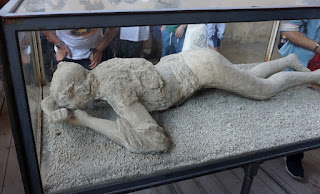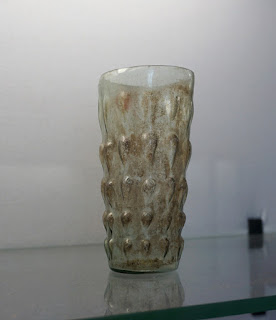May 30, 2023
May 30, 2023
We had a leisurely breakfast on the hotel deck. We are thinking it is a good idea to head out for a couple hours while the day-trippers overwhelm the narrow lanes of this little village of Positano. While we waited for the public bus, Aimee was fascinated by this little gecko that scoured his territory for one insect after another.
We took the bus east along the World Heritage Amalfi Coast. The road, carved into the sheer cliff, is carefully designed to be a little narrower than two cars side by side. The ride was hair-raising for us. I can’t imagine how the bus driver does this day after day. I felt like I needed to give him a tip afterwards.
We got off at the eponymous town of Amalfi, which is the main economic and historical city on this coast. We tried to learn more about this history by visiting the Arsenale Museum. The Republic of Amalfi had the early lead in developing maritime trade with the Orient after the first Crusades. This museum is housed in the old shoreline caves where these merchants built their great oared vessels. Amalfi developed the first ‘rules of the sea’ that the world still abides by. They also refined the first compass to aid navigation. Unfortunately having volcanoes in your back yard is not good for business. In 1343, the Stromboli volcano generated a tsunami that destroyed the town ceding maritime leadership to Genoa, Pisa, and especially Venice.
We walked into town past the Cathedral sitting atop a monumental staircase. We plowed through the tourist crowd uphill along the main drag. We can hear the rushing of water below the pavement. The street covers the river that runs through the center of the town.
After an hour we head back to the port and buy a ticket for the ferry. We want nothing to do with the coast road. The boat ride is faster, smoother, and comes with fresh air, and great scenery.
Back in Positano, we make another late lunch reservation at the same spot as yesterday. We have almost the same table and meal. It is great food and wonderful scenery, above the tourist fray below us.
For dinner I sip some wine by our window. Aimee and I toast our Italian holiday. Tomorrow we start the long journey home. I am going to miss Italian Tiramisu.
We had a leisurely breakfast on the hotel deck. We are thinking it is a good idea to head out for a couple hours while the day-trippers overwhelm the narrow lanes of this little village of Positano. While we waited for the public bus, Aimee was fascinated by this little gecko that scoured his territory for one insect after another.
We took the bus east along the World Heritage Amalfi Coast. The road, carved into the sheer cliff, is carefully designed to be a little narrower than two cars side by side. The ride was hair-raising for us. I can’t imagine how the bus driver does this day after day. I felt like I needed to give him a tip afterwards.
We got off at the eponymous town of Amalfi, which is the main economic and historical city on this coast. We tried to learn more about this history by visiting the Arsenale Museum. The Republic of Amalfi had the early lead in developing maritime trade with the Orient after the first Crusades. This museum is housed in the old shoreline caves where these merchants built their great oared vessels. Amalfi developed the first ‘rules of the sea’ that the world still abides by. They also refined the first compass to aid navigation. Unfortunately having volcanoes in your back yard is not good for business. In 1343, the Stromboli volcano generated a tsunami that destroyed the town ceding maritime leadership to Genoa, Pisa, and especially Venice.
We walked into town past the Cathedral sitting atop a monumental staircase. We plowed through the tourist crowd uphill along the main drag. We can hear the rushing of water below the pavement. The street covers the river that runs through the center of the town.
After an hour we head back to the port and buy a ticket for the ferry. We want nothing to do with the coast road. The boat ride is faster, smoother, and comes with fresh air, and great scenery.
Back in Positano, we make another late lunch reservation at the same spot as yesterday. We have almost the same table and meal. It is great food and wonderful scenery, above the tourist fray below us.
For dinner I sip some wine by our window. Aimee and I toast our Italian holiday. Tomorrow we start the long journey home. I am going to miss Italian Tiramisu.
.jpg)







.jpg)

.jpg)
.jpg)
.jpg)








.jpg)

.jpg)
.jpg)






.jpg)


.jpg)











%20small.jpg)






.jpg)




